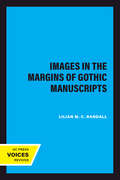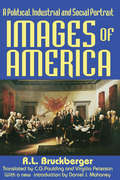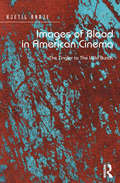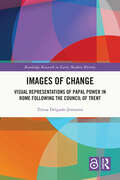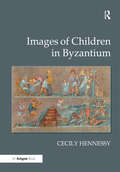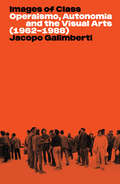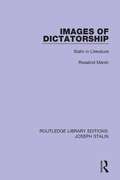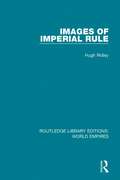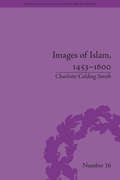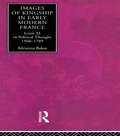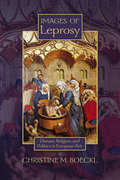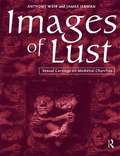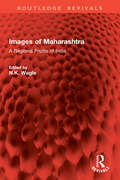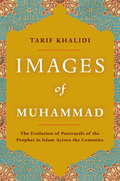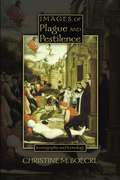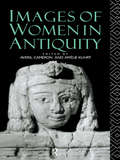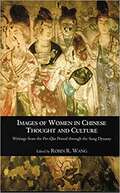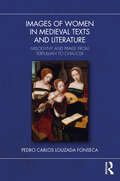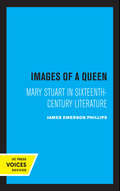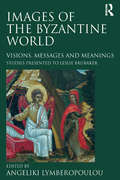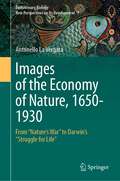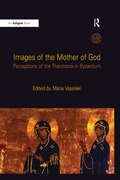- Table View
- List View
Images in the Margins of Gothic Manuscripts (California Studies in the History of Art)
by Lilian M. RandallThis title is part of UC Press's Voices Revived program, which commemorates University of California Press’s mission to seek out and cultivate the brightest minds and give them voice, reach, and impact. Drawing on a backlist dating to 1893, Voices Revived makes high-quality, peer-reviewed scholarship accessible once again using print-on-demand technology. This title was originally published in 1966.This title is part of UC Press's Voices Revived program, which commemorates University of California Press’s mission to seek out and cultivate the brightest minds and give them voice, reach, and impact. Drawing on a backlist dating to 1893, Voices Revived</DIV
Images of America: A Political, Industrial and Social Portrait
by R.L. Bruckberger"Either America is the hope of the world, or it is nothing. Th ere are those who have begun to despair of the West. It is for them that I am writing." Bruckberger's book has been compared by many to Tocqueville's Democracy in America. In both works, Americans see themselves through the sympathetic, sometimes critical eyes of a Frenchman. Bruckberger, as chaplain general of the French Resistance during World War II, was a scholar who lived a life of action, and a priest who knew the life of the spirit. He begins with a celebration of the American past, but also off ers a clear warning for the future.The book was written after Bruckberger's eight years in the United States, during which he thought deeply about the country, and came to love and admire it. He sees what others have not, and his heroes are, in most instances, not the ones normally chosen. As seen from the perspective of the old Europe, the ideas and ideals that have shaped the history and character of America, take on a new meaning. The result is an image of America that is as enlightening as it is surprising.Bruckberger believes America brings to the Western heritage an essential spark, one vital for the angry and perilous post-World War II world, and one equally important today. That is America's regard for the individual, for the non-abstract, living human being. This theme, contrasted with what Bruckberger sees as the heresy of Europe--the subordination of human beings to abstraction is developed with wit and insight.
Images of Anarchy
by Ioannis D. EvrigenisHobbes's concept of the natural condition of mankind became an inescapable point of reference for subsequent political thought, shaping the theories of emulators and critics alike, and has had a profound impact on our understanding of human nature, anarchy, and international relations. Yet, despite Hobbes's insistence on precision, the state of nature is an elusive concept. Has it ever existed and, if so, for whom? Hobbes offered several answers to these questions, which taken together reveal a consistent strategy aimed at providing his readers with a possible, probable, and memorable account of the consequences of disobedience. This book examines the development of this powerful image throughout Hobbes's works, and traces its origins in his sources of inspiration. The resulting trajectory of the state of nature illuminates the ways in which Hobbes employed a rhetoric of science and a science of rhetoric in his relentless pursuit of peace.
Images of Blood in American Cinema: The Tingler to The Wild Bunch
by Kjetil RødjeThrough studying images of blood in film from the mid-1950s to the end of the 1960s, this path-breaking book explores how blood as an (audio)visual cinematic element went from predominately operating as a signifier, providing audiences with information about a film’s plot and characters, to increasingly operating in terms of affect, potentially evoking visceral and embodied responses in viewers. Using films such as The Return of Dracula, The Tingler, Blood Feast, Two Thousand Maniacs, Color Me Blood Red, Bonnie and Clyde, and The Wild Bunch, Rødje takes a novel approach to film history by following one (audio)visual element through an exploration that traverses established standards for film production and reception. This study does not heed distinctions regarding to genres (horror, western, gangster) or models of film production (exploitation, independent, studio productions) but rather maps the operations of cinematic images across marginal as well as more traditionally esteemed cinematic territories. The result is a book that rethinks and reassembles cinematic practices as well as aesthetics, and as such invites new ways to investigate how cinematic images enter relations with other images as well as with audiences.
Images of Change: Visual Representations of Papal Power in Rome Following the Council of Trent (Routledge Research In Early Modern History Ser.)
by Teresa Delgado-JermannImages of Change focuses on the visual propaganda employed by Catholic popes in Rome during the time of Tridentine Reform. In 1563, at the Council of Trent, the Catholic Church decided to reform its own use of imagery, in response to Protestant criticism. This volume examines how different sixteenth-century popes dealt with church reform by looking at the variety of artworks that were commissioned particularly in the city of Rome, the immediate sphere of influence of papal power. Based on original research in the Vatican archives, the book argues that because of the contradictory media strategies employed by individual popes, the papacy began to lose its spiritual and temporal influence and power. This book will appeal to students and scholars alike interested in the Roman Catholic Church in and around the sixteenth century, as well as Early Modern religious reform and Papal influence.
Images of Children in Byzantium
by Cecily HennessyThis book covers a subject that has never previously been addressed, and yet it is both a fascinating and a provocative one: the representation of children in Byzantium. The visual material is extensive, intriguing and striking, and the historical context is crucially important to our understanding of Byzantine culture, social history and artistic output. The imagery explored is drawn from the fourth to the fifteenth centuries and encompasses media from manuscripts to mosaics and enamel. Part of the allure of this subject is that people do not associate childhood with Byzantium. Ernst Gombrich commented, 'who could find it easy, after a visit to Ravenna and its solemn mosaics, to think of noisy children in Byzantium?'. However, in Byzantium, patrons of art were often young, such as emperors who acceded to the throne as teenagers, and makers of art, sculptors, mosaicists, painters often began their training at an early age. How did this affect the creation, promotion and production of art? The study questions the definitions and perceptions of childhood, focusing on topics such as the family, saintly children and those associated with imperial power. Cecily Hennessy demonstrates that children are featured often in visual imagery and in key locations, indicating that they played a central role in Byzantine life, something which has previously been overlooked or ignored. In tackling this new subject she reveals important aspects of childhood, youth, and by extension adulthood in Byzantine society and raises issues that are also applicable to the present and to other historical contexts.
Images of Class: Operaismo, Autonomia and the Visual Arts (1962-1988)
by Jacopo GalimbertiThe first overview of the unique encounter between artists and the prominent Marxist current Workerism, also known as OperaismoDuring the 1960s and 1970s, Workerism and Autonomia were prominent Marxist currents. However, it is rarely acknowledged that these movements inspired many visual artists such as the members of Archizoom, Gordon Matta-Clark and Gianfranco Baruchello. This book focuses on the aesthetic and cultural discourse developed by three generations of militants (including Mario Tronti, Antonio Negri, Bifo and Silvia Federici), and how it was appropriated by artists, architects, graphic designers and architectural historians such as Manfredo Tafuri. Images of Classsignposts key moments of this dialogue, ranging from the drawings published on classe operaia to Potere Operaio&’s exhibition in Paris, the Metropolitan Indians&’ zines, a feminist art collective who adhered to the Wages for Housework Campaign, and the N group&’s experiments with Gestalt theory. Featuring more than 140 images of artworks, many published here for the first time, this volume provides an original perspective on post-war Italian culture and new insights into some of the most influential Marxist movements of the twentieth and twenty-first centuries worldwide.
Images of Dictatorship: Stalin in Literature (Routledge Library Editions: Joseph Stalin)
by Rosalind MarshOriginally published in 1989, this book presented the first study of the image of Stalin in literature. Analysing the literary presentaiton of historical character and the treatment of 20th Century tyrants in European prose fiction, the book draws a comparison between the depiction of Hitler in German literature and Stalin in Russian literature. It explores the way in which Stalin has been portrayed by Soviet, emigré Russian, and European writers including Orwell, Nabokov, Mandelstam, Pasternak and Solzhenitsyn. It examines in detail two important novels which had hitherto received little critical attention: the revised (1978) version of Sozhenitsyn's The First Circle and Anatoly Rybakov's Children of the Arbat. This book will be of interest to students of Soviet/Russian literature, history and politics and those intsted in the relationship between history and fiction in the 20th Century.
Images of Imperial Rule (Routledge Library Editions: World Empires #14)
by Hugh RidleyOriginally published in 1983. In the late nineteenth century as the European powers divided the world between themselves and scrambled over Africa, so their writers went with them, recording in fiction, as well as in historical narrative, the events and issues of the colonial expansion. The literature which they left behind them is the subject of this book. Taking Robinson Crusoe as the starting point for colonial literature, the book looks at linking themes and ideas in the colonial literatures of England, Frances and Germany. In drawing the attention of English-speaking readers to the writing of these other countries, English fiction is placed in a wider context. The comparison also emphasises a homogeneity in the various traditions of colonial literature which goes beyond mere flag waving.
Images of Islam, 1453–1600: Turks in Germany and Central Europe (Religious Cultures in the Early Modern World #16)
by Charlotte Colding SmithUsing evidence from contemporary printed images, Smith examines the attitudes of Christian Europe to the Ottoman Empire and to Islam. She also considers the relationship between text and image, placing it in the cultural context of the Reformation and beyond.
Images of Kingship in Early Modern France: Louis XI in Political Thought, 1560-1789
by Adrianna E. BakosLouis XI, known as "The Spider King" because he wove many intricate plots, lives on in popular imagination primarily as a villain and a cruel, cunning, rather unscrupulous character. Absolutists fled to his banner whilst constitutionalists reviled him as a rapacious totalitarian murderer. In Images of Kingship in Early Modern France, Adrianna Bakos uses the changing nature of Louis XI's historical reputation to explore the intellectual and political climate of early modern France. Using Louis XI's historical reputation as a prism for fresh investigation, Adrianna Bakos offers new, more complex interpretations of the ideological landscape of early modern France. Images of Kingship in Early Modern France is an important contribution to European historiography and to debates on historical versus political interpretations of Kingship.
Images of Leprosy: Disease, Religion, and Politics in European Art (Early Modern Studies #7)
by Christine M. BoecklFrom biblical times to the onset of the Black Death in the fourteenth century, leprosy was considered the worst human affliction, both medically and socially. Only fifty years ago, leprosy, or Hansen’s disease, was an incurable infectious illness, and it still remains a grave global concern. Recently, leprosy has generated attention in scholarly fields from medical science to the visual arts. This interdisciplinary art-historical survey on lepra and its visualization in sculpture, murals, stained glass, and other media provides new information on the history of art, medicine, religion, and European society. Christine M. Boeckl maintains that the various terrifying aspects of the disease dominated the visual narratives of historic and legendary figures stricken with leprosy. For rulers, beggars, saints, and sinners, the metaphor of leprosy becomes the background against which their captivating stories are projected.
Images of Leprosy: Disease, Religion, and Politics in European Art (Early Modern Studies #Vol. 7)
by Christine M. BoecklFrom biblical times to the onset of the Black Death in the fourteenth century, leprosy was considered the worst human affliction, both medically and socially. Only fifty years ago, leprosy, or Hansen’s disease, was an incurable infectious illness, and it still remains a grave global concern. Recently, leprosy has generated attention in scholarly fields from medical science to the visual arts. This interdisciplinary art-historical survey on lepra and its visualization in sculpture, murals, stained glass, and other media provides new information on the history of art, medicine, religion, and European society. Christine M. Boeckl maintains that the various terrifying aspects of the disease dominated the visual narratives of historic and legendary figures stricken with leprosy. For rulers, beggars, saints, and sinners, the metaphor of leprosy becomes the background against which their captivating stories are projected.
Images of Lust: Sexual Carvings on Medieval Churches
by James Jerman Anthony WeirSexually explicit sculptures may be found on a number of medieval churches in France and Spain. This fascinating study examines the origins and purposes of these sculptures, viewing them not as magical fertility symbols, nor even as idols of ancient pre-Christian religions, but as serious works that dealt with the sexual customs and salvation of medieval folk, and thus gave support to the Church's moral teachings.
Images of Maharashtra: A Regional Profile of India (Routledge Revivals)
by N. K. WagleFirst published in 1980, Images of Maharashtra presents the authors’ academic interests in defining the multifaceted personality of Maharashtra. All the papers were presented at the Annual Conferences of Maharashtra Studies Group of the Association for Asian Studies. They range over history, politics, agriculture, sociology, and religion.Milton Israel discusses M.R. Jayakar’s use of English language newspaper of Bombay for the Nationalist cause; Mary Katzenstein examines the government’s response to migration; B.G. Gokhale stresses on the importance of Urban commercial centres of Western Deccan in the 17th century; and Donald Innis’ paper is a tribute to creative efforts of the ‘peasant scientists’. Jayant Lele explores the class, caste and hegemony in rural Maharashtra and Jayshree Gokhale-Turner focuses on the importance of Maharashtra region as a structural unit of study. L.W. Preston presents a historical analysis of the subregional religious centres and N.K. Wagle examines the dilemma of early 19th century British administrators in coping with the problem of social rank. This book will be of interest to students and researchers of Asian studies.
Images of Muhammad: Narratives of the Prophet in Islam Across the Centuries
by Tarif KhalidiFrom one of today's leading Muslim scholars, this compelling look at how the Prophet Muhammad has been portrayed throughout the centuries offers a fascinating history of the diversity of Islamic cultures and beliefs.The Prophet Muhammad has been revered for more than fifteen centuries. Today, one in five people throughout the world calls for daily praises and blessings upon him and holds him up as a model of virtue. In IMAGES OF MUHAMMAD, Tarif Khalidi examines the ways Muhammad has been depicted and revered from the immediate aftermath of his death to the present day. With scholarly authority, Khalidi explores how the "biography" of Muhammad has been constructed, reconstructed, and utilized in various Islamic cultures, and traces the influences that have shaped his image, including the profound effect of negative perceptions promulgated by the West. As he describes the great variety of Islamic beliefs and practices, Khalidi illuminates the values and ideas shared by the Sunni, Shia, and Sufi sects, as well as the differences among them, providing Western readers with a clear, objective perspective on the current conflicts within the Muslim world as well as their global repercussions.From the Hardcover edition.
Images of Plague and Pestilence: Iconography and Iconology (Sixteenth Century Essays & Studies #53)
by Christine M. BoecklSince the late fourteenth century, European artists created an extensive body of images, in paintings, prints, drawings, sculptures, and other media, about the horrors of disease and death, as well as hope and salvation. This interdisciplinary study on disease in metaphysical context is the first general overview of plague art written from an art-historical standpoint. The book selects masterpieces created by Raphael, Titian, Tintoretto, Rubens, Van Dyck, and Poussin, and includes minor works dating from the fourteenth to twentieth centuries. It highlights the most important innovative artistic works that originated during the Renaissance and the Catholic Reformation. This study of the changing iconographic patterns and their iconological interpretations opens a window to the past.
Images of Plague and Pestilence: Iconography and Iconology (Sixteenth Century Essays & Studies #53)
by Christine M. BoecklSince the late fourteenth century, European artists created an extensive body of images, in paintings, prints, drawings, sculptures, and other media, about the horrors of disease and death, as well as hope and salvation. This interdisciplinary study on disease in metaphysical context is the first general overview of plague art written from an art-historical standpoint. The book selects masterpieces created by Raphael, Titian, Tintoretto, Rubens, Van Dyck, and Poussin, and includes minor works dating from the fourteenth to twentieth centuries. It highlights the most important innovative artistic works that originated during the Renaissance and the Catholic Reformation. This study of the changing iconographic patterns and their iconological interpretations opens a window to the past.
Images of Women in Antiquity
by Averil Cameron Amélie KuhrtThe agenda and significance of women in antiquity has gained considerable attention in recent years. In this book diverse roles for and attitudes to women in ancient societies are explored: women as witches, as courtesans, as mothers, as priestesses, as nuns, as heiresses and typically as eranged. The shifting focus is variously economic, social, biological, religious and artistic. The studies cover a wide geographic and chronological range, from the ancient Hittite kingdom to the Byzantine Empires.This book has been brought thoroughly up to date with the addition of a new introduction and addenda to individual chapters.
Images of Women in Chinese Thought and Culture: Writings from The Pre-Qin Period Through the Song Dynasty
by Robin WangThis rich collection of writings--many translated especially for this volume and some available in English for the first time--provides a journey through the history of Chinese culture, tracing the Chinese understanding of women as elucidated in writings spanning more than two thousand years. From the earliest oracle bone inscriptions of the Pre-Qin period through the poems and stories of the Song Dynasty, these works shed light on Chinese images of women and their roles in society in terms of such topics as human nature, cosmology, gender, and virtue.
Images of Women in Medieval Texts and Literature: Misogyny and Praise from Tertullian to Chaucer
by Pedro Carlos FonsecaEmploying a critical and analytical method, this volume takes an innovative approach to existing anthologies of medieval texts, proposing a comprehensive methodology for examining and understanding the historical and cultural construction of the image of women in medieval literature. Critically and analytically appreciating representative works and authors from the medieval period, Images of Women in Medieval Texts and Literature is interested not only in their essayistic examination but also in the intuitive perception of their values. This comprehensive approach fosters a deeper understanding of the image of women, particularly in the context of the Eve/Ave binomial, a dichotomy that shapes the defamation and defense of medieval femininity. The chapters present the misogynistic literary tradition as a comprehensive panorama, out of which emerged medieval literature praising women. Texts by the Fathers of the Church, from Tertullian (2nd century) to Saint Thomas Aquinas (13th century), are followed by those continuing their legacy, represented by Giovanni Boccaccio (14th century) and Geoffrey Chaucer (14th century). Finally, from this vast sea of defamation, toward the late Middle Ages, there emerged works, both anonymous and authorial, in praise of women, such as Dives and Pauper (15th century), The Thrush and the Nightingale (13th century), and the works of John Gower (14th century). Each of these works, in their own unique way, defends the women who were veiled and hidden away in the Middle Ages.
Images of a Queen: Mary Stuart in Sixteenth-Century Literature
by James Emerson PhillipsThis title is part of UC Press's Voices Revived program, which commemorates University of California Press’s mission to seek out and cultivate the brightest minds and give them voice, reach, and impact. Drawing on a backlist dating to 1893, Voices Revived makes high-quality, peer-reviewed scholarship accessible once again using print-on-demand technology. This title was originally published in 1964.
Images of the Byzantine World: Visions, Messages and Meanings: Studies presented to Leslie Brubaker
by Angeliki LymberopoulouThe main themes of this volume are the identification of 'visions', 'messages', and 'meanings' in various facets of Byzantine culture and the possible differences in the perception of these visions, messages and meanings as seen by their original audience and by modern scholars. The volume addresses the methodological question of how far interpretations should go - whether there is a tendency to read too much into too little or whether not enough attention is paid to apparent minutiae that may have been important in their historical context. As the essays span a wide chronological era, they also present a means of assessing the relative degrees of continuity and change in Byzantine visions, messages and meanings over time. Thus, as highlighted in the concluding section, the book discusses the validity of existing notions regarding the fluidity of Byzantine culture: when continuity was a matter of a rigid adherence to traditional values and when a manifestation of the ability to adapt old conventions to new circumstances, and it shows that in some respects, Byzantine cultural history may have been less fragmented than is usually assumed. Similarly, by reflecting not just on new interpretations, but also on the process of interpreting itself, the contributors demonstrate how research within Byzantine studies has evolved over the past thirty years from a set of narrowly defined individual disciplines into a broader exploration of interconnected cultural phenomena.
Images of the Economy of Nature, 1650-1930: From "Nature’s War" to Darwin’s "Struggle for Life" (Evolutionary Biology – New Perspectives on Its Development #7)
by Antonello La VergataThe book discusses ideas concerning the order and balance of nature (or "economy of nature") from the late 17th century to the early 20th century. The perspective taken is broad, longue durée and interdisciplinary, and reveals the interplay of scientific, philosophical, moral and social ideas. The story begins with natural theology (dating roughly to the onset of the so-called Newtonian Revolution) and ends with the First World War. The cut-off date has been chosen for the following reasons: the war changed the state of things, affecting man’s way of looking at, and relating to, nature both directly and indirectly; indeed, it put an end to most applications of Darwinism to society and history, including interpretations of war as a form of the struggle for existence. The author presents an overview of the different images of nature that were involved in these debates, especially in the late 19th century, when a large part of the scientific community paid lip service to ‘Darwinism’, while practically each expert felt free to interpret it in his own distinct way. The book also touches on the so-called ‘social Darwinism’, which was neither a real theory, nor a common body of ideas, and its various views of society and nature’s economy. Part of this book deals with the persistence of moralizing images of nature in the work of many authors. One of the main features of the book is its wealth of (detailed) quotations. In this way the author gives the reader the opportunity to see the original statements on which the author bases his discussion. The author privileges the analysis of different positions over a historiography offering a merely linear narrative based on general implications of ideas and theories. To revisit the concept of the so-called "Darwinian Revolution", we need to examine the various perspectives of scientists and others, their language and, so to speak, the lenses they used when reading "facts" and theories. The book ends with some general reflections on Darwin and Darwinisms (the plural is important) as a case study on the relationship between intellectual history, the history of science and contextual history.Written by a historian, this book really gives new, multidisciplinary perspectives on the "Darwinian Revolution."
Images of the Mother of God: Perceptions of the Theotokos in Byzantium
by Maria VassilakiFully illustrated in colour and black and white, Images of the Mother of God complements the successful exhibition catalogue of the 'Mother of God' exhibition at the Benaki Museum in Athens. It brings together the work of leading international authorities and younger scholars to provide a wide-ranging survey of how the Theotokos was perceived in the Byzantine world. It embraces the disciplines of art historians, archaeologists, traditional and feminist historians, as well as theologians, philologists and social anthropologists. Images of the Mother of God will appeal not just to those interested in Byzantine art and culture, but also to scholars of Western Europe in the Middle Ages who are looking for comparative materials in their own work.
